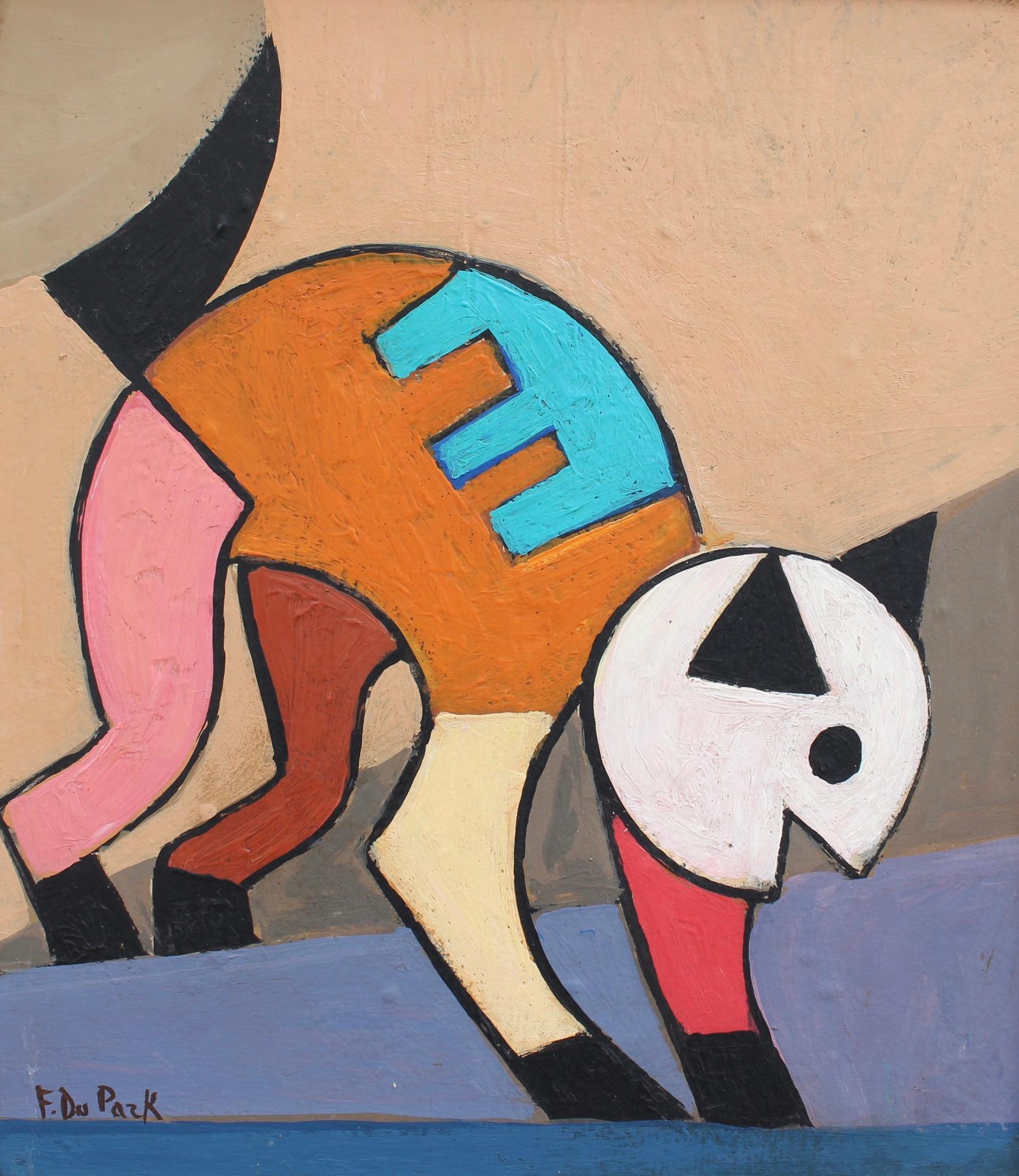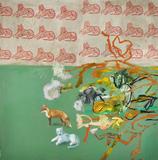Items Similar to 'Portrait of a Reposing Cat', Berlin School
Want more images or videos?
Request additional images or videos from the seller
Unknown'Portrait of a Reposing Cat', Berlin Schoolcirca 1960s
circa 1960s
About the Item
'Portrait of a Reposing Cat', oil on board, by F. DuParc (circa 1960s). A thoroughly modern depiction of a colourful, contented feline most likely inspired by Italian Futurist, Fortunato Depero (1892-1960). Futurism corresponded to Cubism sharing several elements including faceted or segmented shapes. Cubism however, was generally static and more subdued whereas Futurism was bright and dynamic embracing technology, mechanisation, power and energy. In this work, the vibrant colours and serene look on the subject transmit a sense of optimism - life is good and worth living. This painting is in good overall condition having been professionally cleaned and newly framed with a French-style linen slip. The artist's signature, F. DuParc, appears in the lower right hand. Upon request a video will be provided.
About the Art: Our gallery has access to a cache of paintings from the 1940s to the 1970s attributed to an art collective whose traces start with Germany. Berlin to start, but also Dresden, along the Saale, Weimar, Brera in Milan and Brussels. From the post-war period and onwards, they hosted young people who experimented with different painting techniques with exceptionally creative results. Over the years, dedicated art-seekers managed to unearth a treasure trove of these works from forgotten repositories. Once examined, the paintings were presented first to the Italian art market and then beyond, to art lovers in Europe and the United States.
Quietly, but surely, word of mouth scattered the news of the existence of these found artworks: cubist, expressionist, futurist and avant-garde. Trying to label these pieces doesn’t do them justice truly, but to call them studies, sketches, or simply, creations, would be more accurate.
It is interesting to note the artworks were very often unsigned, but often as not, initialled or monogrammed. Using known masterpieces as reference, their mentors suggested a particular style with which to experiment. Regrettably, this makes it impossible to pinpoint who amongst these bright creatives ‘made it’ in the world of art. But it really doesn’t matter. Each piece we've selected is extraordinary and therein lies the interest in these works. Notwithstanding that, several galleries have acquired and are now selling pieces from this body of work. This clearly speaks to the widespread assessment of the quality and interest of the art.
Today, these creations hang on the walls of art lovers in London, Paris, New York, Hong Kong, Miami and Los Angeles. Galleries scramble to acquire the works having recognised the outstanding potential in the international art markets for these pieces with such fascinating origins.
Dimensions with frame:
H 41.5 cm / 16.3"
W 51.5 cm / 20.3"
Dimensions without frame:
H 28.5 cm / 11.2"
W 38.5 cm / 15.2"
- Creation Year:circa 1960s
- Dimensions:Height: 16.34 in (41.5 cm)Width: 20.28 in (51.5 cm)
- Medium:
- Movement & Style:
- Period:
- Condition:
- Gallery Location:London, GB
- Reference Number:
About the Seller
5.0
Platinum Seller
These expertly vetted sellers are 1stDibs' most experienced sellers and are rated highest by our customers.
Established in 2016
1stDibs seller since 2017
439 sales on 1stDibs
Typical response time: <1 hour
- ShippingRetrieving quote...Ships From: London, United Kingdom
- Return PolicyA return for this item may be initiated within 7 days of delivery.
More From This SellerView All
- 'Playful Feline', Berlin SchoolLocated in London, GB'Playful Feline', oil on board, Berlin School (circa 1960s). A thoroughly modern depiction of a colourful, willowy feline most likely inspired by Italian...Category
1960s Futurist Animal Paintings
MaterialsOil, Board
- 'The Stray Cat', Berlin SchoolLocated in London, GB'The Stray Cat', oil on board, by F. DuParc (circa 1960s). A thoroughly modern depiction of a colourful, graceful feline most likely inspired by Italian Futurist, Fortunato Depero (1...Category
1960s Futurist Abstract Paintings
MaterialsOil, Board
- 'Portrait of Future Man', German SchoolLocated in London, GB'Portrait of Future Man', oil on board, Berlin School, (circa 1960s). A thoroughly modern portrait clearly in the style of Italian Futurist, Fortunato Depero (1892-1960). Futurism co...Category
1960s Futurist Abstract Paintings
MaterialsOil, Board
- Still Life with CrabBy André LemaîtreLocated in London, GB'Still Life with Crab', oil on board, by André Lemaître (1951). As an artist based in Northern France's Normandy, Lemaître painted many works in the cou...Category
1950s Still-life Paintings
MaterialsOil, Board
- Portrait of a Woman and Her HorseLocated in London, GB'Portrait of a Woman and Her Horse', oil on board, French School (1988). Horses are majestic, strong and can display a broad range of emotions. Whether they're around humans or other...Category
1980s Animal Paintings
MaterialsOil, Board
- 'Portrait of a Bird in Snow' French Vintage Oil PaintingLocated in London, GB'Portrait of a Bird in Snow', oil on board, by Anna Costa (circa 1960s). This is a unique still-life painted by the artist in warm colours in an Impressi...Category
1960s Impressionist Animal Paintings
MaterialsOil, Board
You May Also Like
- Feelings. 2019, hardboard, oil, 39x28 cmBy Dmitry LavrentjevLocated in Riga, LVFeelings. 2019, hardboard, oil, 39x28 cmCategory
2010s Abstract Expressionist Abstract Paintings
MaterialsOil, Cardboard
- Mid 20th Century oil painting of a cicada by Belgian artist BaugnietLocated in Petworth, West SussexMarcel Louis Baugniet (Belgian, 1896 – 1995) Sigale de Mer (Cicada of the sea) Oil on board with scraffito Signed ‘M L BAUGNIET / 47’ (upper right) 17.3/4 x 13.1/2 in. (45 x 34.3 cm.) Marcel-Louis Baugniet was born in Liege on the 18th March 1896. Painter, theorist, furniture designer, creator of posters, costumes and stage sets, he was one of the main defenders of the notion of Pure Plastic Arts. Baugniet studied painting at the Royal Academy of Beaux-Arts in Brussels where he mixed with Paul Delvaux, René Magritte, Victor Servrancks and Pierre-Louis Flouquet. He spent some time in Paris and decided that he would become an iconoclastic and avant garde artist. He discovered abstract art with Kandinsky, Kupka, Mondrian and Delaunay and with wonder and stupeur he also learnt of the constructivist movement, which was born in Russia with Malevitch and Lissitsky. In 1922, Baugniet then 26 years old returned to Brussels and married the Russian danser Akarova for whom he designed costumes and stage sets. M-L Baugniet painted, designed and engraved some superb series of dansers and sportspersons (the « Kaloprosopies »), works entrenched with impeccable lines of constructed art. He painted with contemplation geometric compositions which mixed a grace of colours with the rigour of shapes. Baugniet wrote articles on esthetics and applicated arts in the magasine 7 Arts and edited, with the Dutch architect Van Tonderen, the manifesto of the movement that they called « Le beau, C’est l'utile » (beauty is useful) Towards the end of the 20s, he separated from Akarova and in 1927 he opened his own Home Decor shop. With regret Baugniet laid down his paint brushes and threw himself into interior design and the creation of tubular furniture, everyday objects and carpets. He remarried the Russian Olga Reich. He created a circle of ideas that included artists, writers, politicians and intellectuals of all kinds. Throughout his career, Baugniet participated in numerous international exhibitions of decorative art. In 1977 abstraction, constructivism and Marcel-Louis Baugniet were rediscovered. Decorated and lauded, Baugniet began to paint once more and co-founded the magasine Mesures with Jo Delahaut...Category
Mid-20th Century Expressionist Animal Paintings
MaterialsOil, Board
- British, 21st Century abstract oil painting 'Moonlit Horses'By Max AndrewsLocated in Petworth, West SussexMax Andrews (British, b. 1969) Moonlit horses Signed and dated ‘Max Andrews 19’ (lower right) Oil on board 12.1/5 x 12.1/5 in. (32 x 31.8 cm.)Category
21st Century and Contemporary Abstract Animal Paintings
MaterialsOil, Board
- Still Life with Tiger and FoxBy Mary VernonLocated in Dallas, TX"In the world of still life and landscape, conceptual events meet one another – the structural meets the narrative, the small stands in the space of the large, and color has a chance...Category
2010s Contemporary Abstract Paintings
MaterialsBoard, Oil, Paper
- Coyote (Highway 380)By Mary VernonLocated in Dallas, TX"In the world of still life and landscape, conceptual events meet one another – the structural meets the narrative, the small stands in the space of the large, and color has a chance...Category
2010s Contemporary Animal Paintings
MaterialsInk, Oil, Board
- "Blue Fish"By Vaclav VytlacilLocated in Lambertville, NJJim’s of Lambertville is proud to offer this artwork by: Vaclav Vytlacil (1892-1984) He was born to Czechoslovakian parents in 1892 in New York City. Living in Chicago as a youth, he took classes at the School of the Art Institute of Chicago, returning to New York when he was 20. From 1913 to 1916, he enjoyed a scholarship from the Art Students League, and worked with John C. Johansen (a portraitist whose expressive style resembled that of John Singer Sargent), and Anders Zorn. He accepted a teaching position at the Minneapolis School of Art in 1916, remaining there until 1921. This enabled him to travel to Europe to study Cézanne’s paintings and works of the Old Masters. He traveled to Paris, Prague, Dresden, Berlin, and Munich seeking the works of Titian, Cranach, Rembrandt, Veronese, and Holbein, which gave him new perspective. Vytlacil studied at the Royal Academy of Art in Munich, settling there in 1921. Fellow students were Ernest Thurn and Worth Ryder, who introduced him to famous abstractionist Hans Hofmann. He worked with Hofmann from about 1922 to 1926, as a student and teaching assistant. During the summer of 1928, after returning to the United States, Vytlacil gave lectures at the University of California, Berkeley, on modern European art. Soon thereafter, he became a member of the Art Students League faculty. After one year, he returned to Europe and successfully persuaded Hofmann to teach at the League as well. He spent about six years in Europe, studying the works of Matisse, Picasso, and Dufy. In 1935, he returned to New York and became a co-founder of the American Abstract Artists group in 1936. He later had teaching posts at Queens College in New York; the College of Arts and Crafts in Oakland, California; Black Mountain College in North Carolina; and the Art Students League. His paintings exhibit a clear inclination toward modernism. His still lives and interiors from the 1920s indicate an understanding of the art of Cézanne. In the 1930s, his works displayed two very different kinds of art at the same time. His cityscapes and landscapes combine Cubist-inspired spatial concerns with an expressionistic approach to line and color. Vytlacil also used old wood, metal, cork, and string in constructions, influenced by his friend and former student, Rupert Turnbull. He eventually ceased creating constructions as he considered them too limiting. The spatial challenges of painting were still his preference. During the 1940s and 1950s, his works indicated a sense of spontaneity not felt in his earlier work. He married Elizabeth Foster in Florence, Italy, in 1927 and they lived and worked in Positano, Italy for extended periods of time. Later on, they divided their time between homes in Sparkill, New York and Chilmark, Massachusetts, where Vyt, as he was affectionately called, taught at the Martha's Vineyard Art...Category
1960s Abstract Expressionist Abstract Paintings
MaterialsOil, Board



